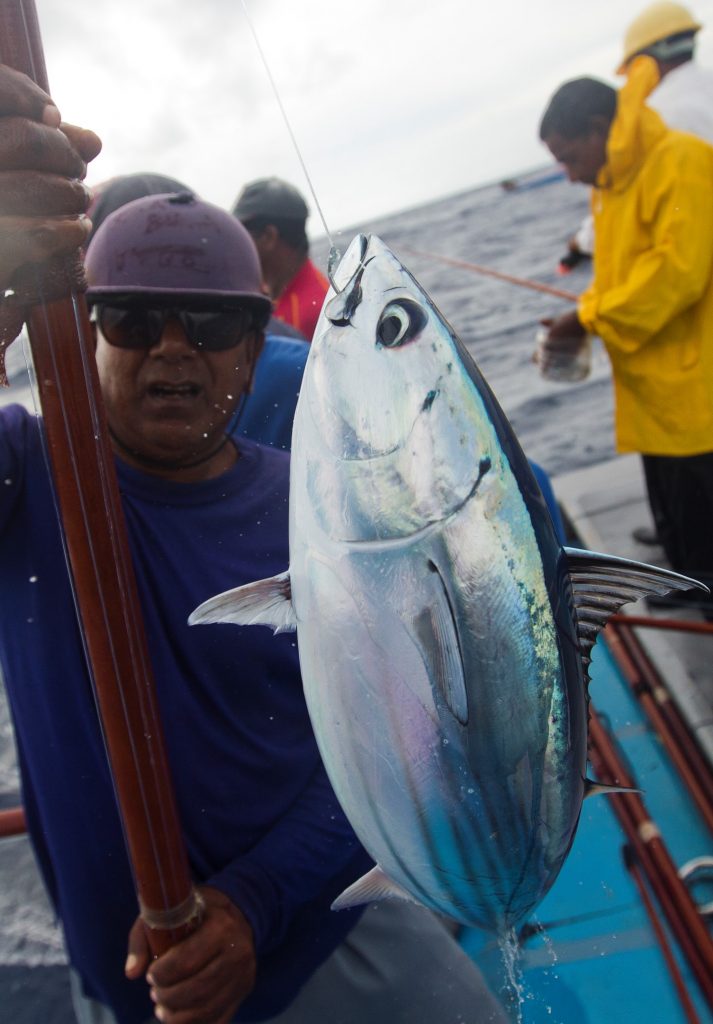22 novembre 2022
Tuna…the name conjures images of thousand-pound torpedoes, crisscrossing the oceans propelled by a tailfin that slashes through the water like a broadsword.
Giants that snap rods and leave even the toughest anglers weary from hours of battle.
Trophy fish that can sell for millions of dollars, fit for exclusive sushi restaurants.
The ultimate image for seafood as a luxury good…yet nothing could be further from the truth.

Of the 5.2 million metric tons of tuna caught in commercial fisheries around the world every year, more than half comes from a single species – skipjack tuna – that is not much larger than a loaf of bread. Primarily destined for canneries, skipjack tunas sell for about 1/10th of the price of the more illustrious bluefin. And more than half of the world’s commercial catch of skipjack tuna comes from a single fishery in the Pacific that next week has the opportunity to implement its most important management decision ever to safeguard its future.
After years of investment and intense scientific analysis, a harvest strategy (or management procedure) could finally be adopted next week at the annual meeting of the Western and Central Pacific Fisheries Commission (WCPFC). This harvest strategy, designed to balance conservation and commercial interests, would ensure that fishing opportunities are decided based upon the best available science for years to come.
It comes at a pivotal moment because, while the western and central Pacific skipjack stock is not overfished nor is overfishing occurring, the stock has been continually declining over the long term and faces an uncertain future with growing demand for seafood and concern among scientists about how it may be at risk to climate change impacts. As I wrote in a recent blog for COP27, all fisheries need to proactively enact adaptive management practices to prepare for a changing climate, and harvest strategies are our “best bet” for doing that. But choosing to delay implementation of the harvest strategy indefinitely, as the draft proposal outlines, will only expose the fishery to unnecessary risk. That’s why we and others have opposed this proposed “trial period.”
As we approach the end of November, it’s common tradition in the United States to gather together with friends and family for the holiday of Thanksgiving and celebrate what we are thankful for. And if you are reading this, I hope you can be thankful for a few things about the world’s largest tuna fishery:
That Pacific skipjack tuna stocks the shelves of grocery stores with canned food in quantities that are about the same as the amount of turkey consumed in the United States each year (and with a much lower carbon footprint!)
That tuna fishing supports up to 84% of government revenue and is the largest source of income for several Pacific island nations.
That science has given us the tools to manage fisheries in a healthy state for generations to come…if we choose to use it!
Now imagine a world where all that disappears…and it’s clear to see why we cannot take skipjack tuna for granted in the western and central Pacific. Fortunately, there are two things up for adoption at the WCPFC meeting next week that can help avoid that. In addition to the skipjack harvest strategy, WCPFC members should formalize its Science Management Dialogue as a permanent body of the Commission. Serving as a forum for discussion among scientists, managers, and other stakeholders on all harvest strategy-related matters, key tasks for next year would include developing a monitoring strategy for skipjack and advancing harvest strategies for other valuable WCPFC species such as yellowfin, bigeye and South Pacific albacore.
Fisheries do feed people. Entire countries do depend on them. And with proper fisheries science and management, fisheries like Pacific skipjack can be sustainable. So, as we like to say, Don’t Skip Skipjack!